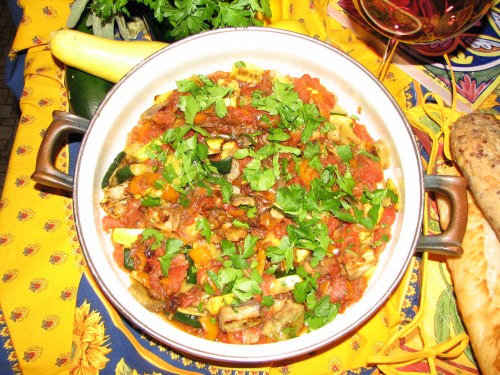
Ratatouille is signature dish of the the Provence region of southeastern France. The word ratatouille is derived from the verb touiller which means "to stir up." The dish is tremendously popular throughout France because it is easy to prepare, uses abundantly available ingredients, and can be served cold or warm.
The Provence region lies along the Mediterranean Sea just west of Italy. Provence's diverse topography is characterized by mountains, valleys, and beautiful beaches. (Sound familiar, San Diegans?) Originally a Greek colony, Provence was once a part of the Roman Empire and was eventually incorporated into France in the 15th century.<
The region's warm weather, coastal location, and the impact of other Mediterranean culinary influences has produced a cuisine at odds with stereotypical notions of French food. The Provencal cooking is more akin to neighboring Italy than to the rest of France.
It is said that there are three foundations to Provence cuisine: olive oil, garlic, and aromatic herbs (such as herbs de Provence). This makes ratatouille a quintessential Provencal dish
Our recipe and preparation follow the notion that in order to “do ratatouille right,” the component flavors should not be mixed and muddled. The vegetables should be cooked separately and then arranged in layers so that each will retain their distinct flavors.<
The following recipe is was adapted from "Mastering the Art of French Cooking" by Simone Beck, Louisette Bertholle, and Julia Child.
Ingredients
- ½ pound eggplant
- ½ pound zucchini
- 1 tsp. salt
- 4 tablespoon olive oil, more if needed
- ½ pound (about 1 ½ cups) thinly sliced yellow onions
- 2 (about 1 cup) sliced green bell peppers (orange peppers were used in this preparation.)
- 2-3 tablespoons olive oil, if necessary
- 2 cloves mashed garlic
- 1 pound firm, ripe, red tomatoes, peeled, seeded and juiced to make 1 ½ cups pulp
- 3 tablespoons minced parsley (Italian parsley used here.)
- Salt and pepper to taste
Preparation:
- Peel the eggplant and cut into slices 3/8 inch thick, about 3 inches long, and 1 inch wide.
- Place in a bowl and toss with salt. Let stand for 30 minutes. Salting and rinsing—"known as "degorging"—will soften and remove much of the eggplant's bitterness. Eggplant is capable of absorbing large amounts of cooking fats and sauces, allowing for very rich dishes, salting process will reduce the absorbtion of oil absorbed.
- Scrub the zucchini, slice off the two ends, and cut up like the eggplant.
- Place in a bowl and toss with salt. Let stand for 30 minutes.
- Drain the eggplant and zucchini slices and dry them on a towel.
- One layer at a time, sauté (for about one minute) the eggplant in hot olive oil. When lightly browned on each side, remove from pan and set aside. Sauté the zucchini in a similar fashion.
- In the same skillet, cook the onions and the peppers slowly in olive oil for about 10 minutes, or until tender but now browned. Stir in the garlic and season to taste.
- Boil a small pot of water and immerse the tomatoes for about 10 seconds. Remove, cool, and peel off the skins.
- Slice the peeled tomatoes through the center, and gently squeeze them over a bowl to extract the juices and seeds. Slice the juiced and seeded tomatoes into 3/8 inch strips. Lay the sliced tomato pulp over the onions and peppers. Season with salt and pepper. Cover the skillet and cook over low heat for 5 minutes, or until the tomatoes have begun to render their juice. Uncover, baste with the juices, raise heat and boil for several minutes, until juice has almost evaporated.
- Place a third of the tomato mixture in the bottom of a heavy casserole pot (the recipe calls for a 2 1/2 quart fireproof casserole about 2 1/2 inches deep) and sprinkle over it 1 Tb. of parsley.
- Arrange half of the eggplant and zucchini on top, then half the remaining tomatoes and parsley. Put in the rest of the eggplant and zucchini, and finish with the remaining tomatoes and parsley.
- Cover the casserole and simmer over low heat for 10 minutes. Uncover, tip casserole and baste with the rendered juices Correct seasoning, if necessary. Raise heat slightly and cook uncovered for about 15 minutes more, basting several times, until juices have evaporated leaving a spoonful or two of flavored olive oil. Be careful of your heat; do not let the vegetables scorch in the bottom of the casserole.
- Set aside, uncovered, and reheat slowly at serving time, or serve cold.
Bon Appétit
Text by David Craven
Photos and dish preparation by Pattie Anderson








